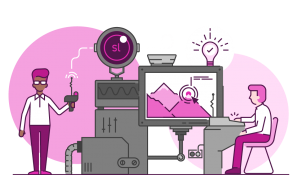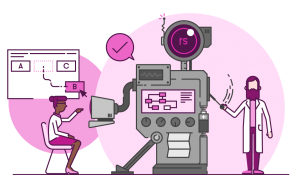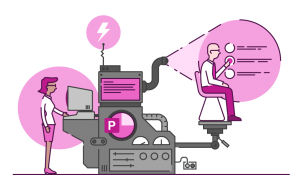eLearning has the potential to transform training content. It allows businesses to educate entire workforces at a pace, time, and location that suits them, saving on some of the costs associated with classroom-led training. But if you’re new to creating eLearning content, it can be hard to know where to start.
While it’s possible to buy eLearning content off the shelf or engage an eLearning design agency to create bespoke training, the responsibility for creating eLearning courses often falls to members of internal departments. Whether you’re coming to eLearning courses from a presentation background or are already an expert in creating training content for face to face training, creating eLearning courses is a whole different kettle of fish.
It’s so important to master the fundamentals of eLearning creation. If you don’t have the skills needed to create really effective content, your learners may have to read through lengthy PowerPoint presentations, navigate wordy compliance documents, or complete poorly written assessments; none of this results in a successful eLearning experience!
But never fear, BrightCarbon are here to help you get to grips with the basics of creating eLearning courses. In this post we’ll outline three key steps to creating eLearning content that works, the skills you need to practice in order to achieve results at each stage, and some helpful tools and resources that will guide you along the way.
The work that goes into high quality eLearning creation is significant, and of course we’re not going to be able to teach you everything in just one post. But use this article as a jumping off point, to give you some structure and pique your interest. And keep your eye on our blog and events page for masterclasses to help you continue to develop your skills and make even better eLearning content. So, without further ado, here’s 3 steps to creating eLearning that really takes off!
Creating eLearning, step 1: Gather the information
Information is power. At the start of any kind of instructional design project, it’s vital that you get as much information as possible so that you can create an eLearning course that really delivers. The information you need to gather broadly fits into three categories: information about the business, information about the learners, and information about technical requirements.
The business
Whether you’re creating content for use within your own business or for a client, you need to understand the business requirements before you start putting together any course materials.
An eLearning course doesn’t exist in a vacuum: you’ll have to consider how the course fits with the business’ training initiatives. If the business doesn’t have an established eLearning programme it’ll be important to market your course within the business to aid engagement. Talk to people involved in training and development, to managers or the HR department in order to get the lay of the land.
Engage with management and subject matter experts to find out what’s happening in the business that needs to change. Clarify the business objectives that the eLearning is trying to solve and ensure that the problems you’re addressing are ones that training can actually impact. This is also a good time to set your client or colleagues’ expectations about what can and can’t be achieved with eLearning. Check out this guide for insights into what can be solved with training, and what can’t, and this piece to learn how to align business objectives with the goals of your eLearning course.
The learners
User experience (UX) design is a key aspect of creating eLearning courses; it’s vital to understand the learners who will end up using your eLearning so that you can create something that works well for them and enables them to meet the learning objectives.
Direct engagement with learners through focus groups or surveys is a great way to find out more about them, but if that’s not possible then at least aim to gather key facts about learners’ professional level, IT literacy, where their knowledge/skill level is now versus where the business needs it to be. You can use the information you gather to create personas that guide course development, a handy practice from the world of UX design.
Finding out about the needs of learners from the start will also help you to create accessible content. We cover how disability and eLearning interact, and some practical steps to making accessible training materials, in this post.
Technical requirements
When you’re planning face to face training courses it’s important to consider the logistics involved: the same applies to rolling out eLearning courses. You need to understand how the eLearning content will be distributed. Find out what devices learners will use to access it, if they’ll have an internet connection, and whether a learning management system (LMS) will be used to facilitate and track the training. If an LMS is required, but has not yet been implemented, you may have to do some work up front to set up that infrastructure. If you need an LMS 101, check out this guide.
Talk to the IT department and make sure you have clarity on the technical requirements from the start, especially if you’re going to be making a multimedia-rich, visual course (an approach we’d recommend!).
Creating eLearning, step 2: Structure the content
Once you have all the background information, you’re ready to actually start tackling the course content. In order to get the content structured and ready to be built as eLearning you need to move from information to objectives, from objectives to methods, and from methods to content. Lost? Read on!
Writing learning objectives
It’s important to think critically about what you want learners to be able to do differently after completing the eLearning course. Sometimes the objectives for training are really simple, like ‘We need learners to know who to contact if they can’t log in to our online portal’. And sometimes they’re a bit trickier, like ‘We need our staff to change their attitude towards diversity in the workplace’.
By writing clear, measurable learning objectives you give yourself a good foundation from which to create an eLearning course that actually meets business goals. Learning objectives are there to help you, as an eLearning designer, to understand what content you need and how to structure it. They should help you to keep the content focused, steering clear of the dreaded knowledge dump style of eLearning.
We’ve briefly covered learning objectives on the blog before, but if you need something a bit more detailed to help you then check out this excellent series of posts from Connie Malamed.
Matching methods to objectives
Within a single eLearning course, you have the opportunity to use many different types of instruction. This is handy because different types of learning objectives require different teaching methods. Are you trying to share information or raise awareness? Improve knowledge or skills? Or change attitudes or behaviour? Depending on your answer, text, diagrams, videos, quizzes, scenarios, or other type of interactions could be the best fit for your training.
For example, let’s imagine you’re creating some eLearning about making insurance claims. One of your learning objectives might be for learners to be able to “Outline the criteria that a valid claim must meet.” Learners will need to know what the criteria are and recall that information. A good method for teaching this could be a short video which outlines the criteria, followed by a quiz with questions that require learners to list the criteria.
A second learning objective might for learners to be able to “Decide whether an insurance claim is valid.” For this type of objective, which requires discrimination and decision-making skills, it might be good to use an interaction where learners are presented with a sample insurance claim and practice making a decision about its validity.
Figuring out which method works best will depend on the tools and skills you have available. It’s something that takes experience and practice to master. Have a read of Chapter 4 of The Accidental Instructional Designer by Cammy Bean for some great inspiration for methods of instruction that you can use in eLearning. Take a look at existing eLearning content for even more inspiration; e-Learning Heroes and Allen Interactions have libraries of great examples that you can take a peek at for inspiration.
Matching content to methods
Once you’ve chosen the methods that will work best for each learning objective, it’s time to turn to the content. You can get the content from existing training materials, independent research, or by working with subject matter experts.
While it’s so tempting to try to stuff everything possible into your eLearning course, try to resist. Use your objectives and training methods to guide you to the right chunks of content that learners really need in order to meet the goals. If there’s some content that doesn’t address a learning objective or work in the methods you’ve chosen, leave it out of your course. If you think it’ll be useful, find another way of delivering it to learners, such as a job aid or a resource that they can access at a more appropriate way or time.
Creating eLearning, step 3: Build the course
Now it’s time to actually create the end product. Use the skills and software that you have available. That might mean using dedicated eLearning creation software. It’s also possible to create great interactive courses using just PowerPoint, and some pretty impressive animated content, too. Or your LMS might have course creation capabilities. Whatever tool you’re using, be sure to keep the information you gathered about your learner and technical requirements in the front of your mind throughout the build.
The importance of testing and iterating when designing interactive content can’t be understated. Use accessibility checking tools as you go. Test early and test often. If it’s possible to test directly with learners, then take the opportunity to do so. You’ll learn a lot about what’s working and what can be improved, from the instructions on interactions, to the design of buttons, to whether voiceover is the right pace. If you can’t get a hold of learners to test directly, then engaging your colleagues or a dedicated testing team to check that everything is working well is also a good option.
And there you have it. Three steps that form a clear path to take you from eLearning creation novice, to pro! As you continue your journey into instructional design, we hope you stay tuned into our regular blog posts and free online masterclasses on eLearning topics. Plus, follow us on Twitter for regular tips on making brilliant digital content using everyone’s favourite slide-based authoring tool, trusty PowerPoint.
Leave a comment




